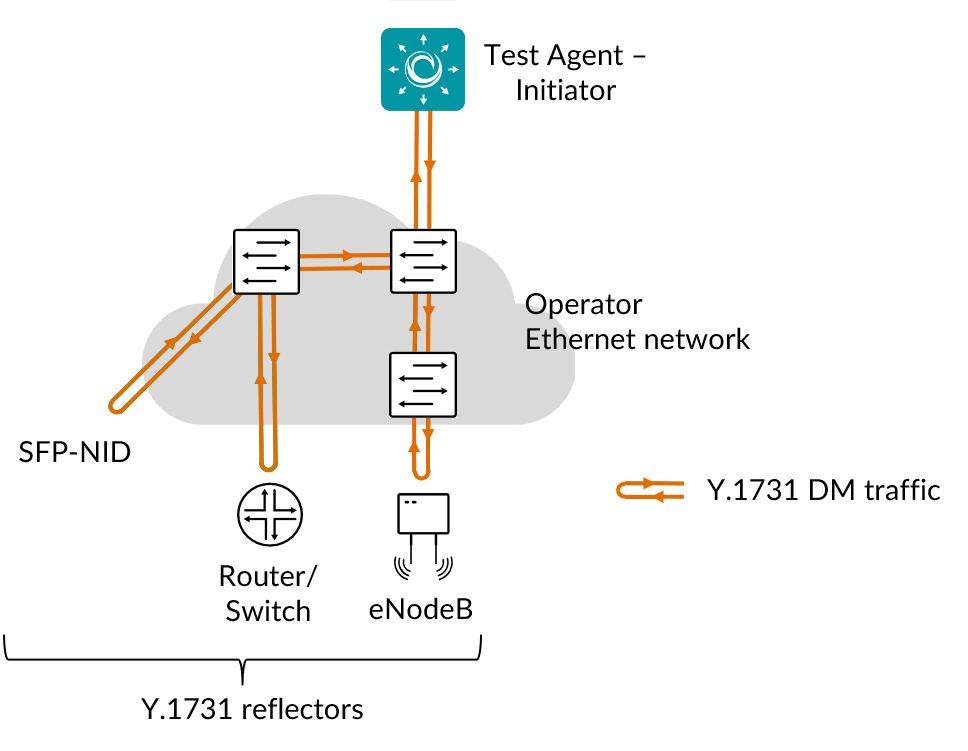Y.1731 delay measurement (ETH-DM)¶
This task lets you send traffic from a Test Agent towards a Y.1731 ETH-DM capable device. Frame delay and frame delay variation measurements are collected by sending periodic frames with ETH-DM information to the peer MEP and receiving frames with ETH-DM information from the peer MEP during a proactive measurement session and/or diagnostic interval. Each MEP may perform frame delay and frame delay variation measurement.

Y.1731 is a Layer 2 protocol, and Layer 2 connectivity is therefore required between the Test Agent and the device you are testing towards.
This task works with both IPv4 and IPv6.
Prerequisites¶
To run a Y.1731 ETH-DM measurement, you need to have at least one Test Agent installed as well as one or several Y.1731-enabled devices in your network. See the installation guides found here for instructions on how to deploy a new Test Agent. Regarding enabling of Y.1731 on your devices, consult your equipment vendor.
You also need to prepare a Y.1731 MEP list in Routing Active Testing, as explained on this page.
Then add an ETH-DM task to your test or monitor and fill in the mandatory parameters below:
Parameters¶
See the common parameters page for the following:
Parameters that are set on the test step level: Duration, Fail threshold, and Wait for ready.
SLA thresholds for monitors: SLA Good and SLA Acceptable.
Advanced settings common to all test tasks: Delayed start.
General¶
Clients: Test Agent interfaces that will act as initiating MEPs.
MEPs (MAC addresses): List of reflector MEPs containing MAC addresses.
Rate (Mbit/s): Rate at which clients will send frames in Mbit/s.
Rate (packets/s): Rate at which clients will send frames in packets/s.
Min: 2 packets/s. Max: 1,000,000 packets/s.Frame size (bytes): Size of Layer 2 Ethernet frame.
See this page. Min: 64 bytes. Max: 9018 bytes. Default: 1518 bytes.
Once Frame size is defined, changing one Rate parameter will cause the other to adjust automatically to agree with it.
Thresholds for errored seconds (ES)¶
Delay (ms): One-way delay threshold for triggering an errored second.
If the delay between server and clients exceeds this value during one second, an ES will be indicated. Min: 1 ms. No default.Delay variation (ms): Jitter threshold for triggering an errored second.
If the jitter (delay variation) between server and clients exceeds this value during one second, an ES will be indicated. Min: 1 ms. No default.
Thresholds for severely errored seconds (SES)¶
Delay (ms): One-way delay threshold for triggering a severely errored second. If the delay between server and clients exceeds this value during one second, an SES will be indicated. Min: 1 ms. No default.
Delay variation (ms): Delay variation (jitter) threshold for triggering a severely errored second. If the delay variation between server and clients exceeds this value during one second, an SES will be indicated. Min: 1 ms. No default.
Advanced¶
VLAN priority (PCP): Priority Code Point to use in the VLAN header.
See this page. Default: 0.
Result metrics¶
Rate (Mbit/s): Actual rate at which clients sent Y.1731 frames.
Sent (packets): Number of sent packets.
Received (packets): Number of received packets.
Min delay near (ms): Minimum one-way delay, near end.
Average delay near (ms): Average one-way delay, near end.
Max delay near (ms): Maximum one-way delay, near end.
Delay variation near (ms): Delay variation, near end.
Min delay far (ms): Minimum one-way delay, far end.
Average delay far (ms): Average one-way delay, far end.
Max delay far (ms): Maximum one-way delay, far end.
Delay variation far (ms): Delay variation, far end.
ES (%): Aggregated errored second (ES) percentage, taking into account all types of error.
ES delay (%): Errored second percentage for delay.
ES delay variation (%): Errored second percentage for delay variation.
SES (%): Aggregated severely errored second (SES) percentage, taking into account all types of error.
Unavailable seconds (%): Unavailable second (UAS) percentage.
SLA: Service level agreement fulfillment: equal to (100 – ES) %.